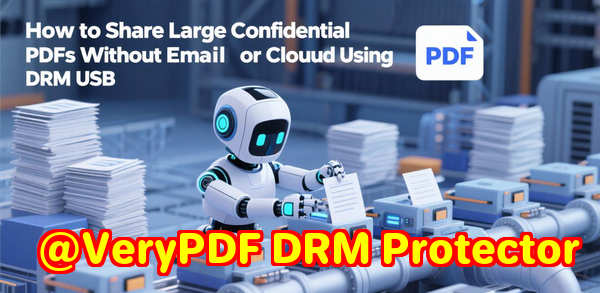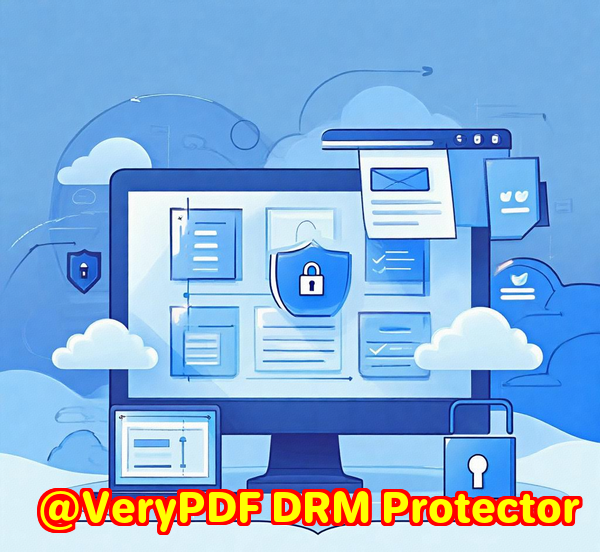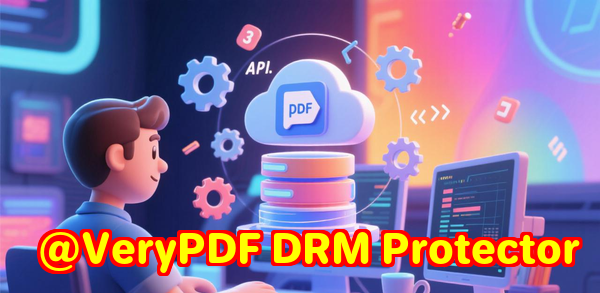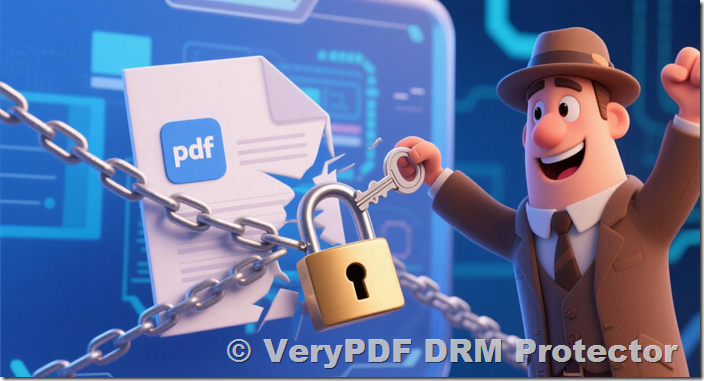Blackboard LMS Research Centers Rely on VeryPDF DRM Protector for Long-Term PDF Security and Compliance
Every time I walked into our research centre’s document archive, I felt a knot in my stomach. PDFs piled high, containing sensitive research data, student submissions, and proprietary methodologiesyet anyone with a USB drive could copy them in seconds. We needed a solution that didn’t just lock files but made sure they stayed secure across systems like Blackboard LMS. That’s when I discovered VeryPDF DRM Protector.
I was initially skeptical because we had tried other PDF protection tools. Some were clunky, others slowed down workflows, and most didn’t integrate with our LMS, CRM, or ERP systems. But VeryPDF promised a seamless, enterprise-grade DRM system that could handle everything from dynamic watermarks to real-time access controls.
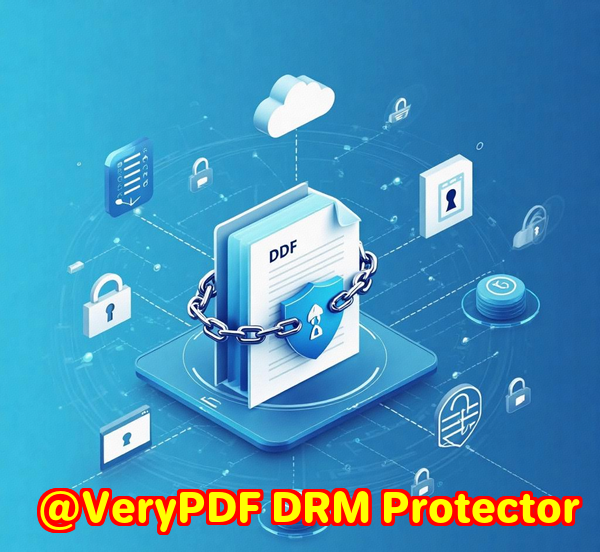
Why VeryPDF DRM Protector Works for Research Centers
As a research professional, I can tell you that PDF security isn’t just about encryption. It’s about controlling who sees what, when, and how. VeryPDF DRM Protector integrates with multiple platforms we rely on daily:
-
LMS platforms like Moodle and Canvas for course materials.
-
CMS systems such as WordPress, Joomla, and Drupal for internal documentation.
-
CRM and ERP systems including Salesforce and SAP to track interactions.
-
Cloud storage services like Google Drive and Dropbox.
This means PDFs are not only encrypted but also dynamically watermarked and controlled based on user roles, devices, or even IP addresses.
I tested it in a scenario where a PhD student wanted to share our latest methodology with collaborators. Normally, I’d worry about leaks. With VeryPDF, I could:
-
Restrict the PDF to specific devices.
-
Set an expiration date for access.
-
Apply dynamic watermarks displaying the user’s name and timestamp.
By the time the student opened the file, every page already carried their credentials invisibly, so unauthorized sharing became practically impossible.
Key Features That Changed the Game
1. Dynamic Watermarking
Dynamic watermarking is a game-changer. Unlike static watermarks that can be cropped or removed, VeryPDF’s watermarks are automatically applied per user session. For example, one of our researchers tried taking screenshots, but the watermark appeared on every image, including zoomed-in sections. This gave us peace of mind and discouraged casual sharing.
2. Granular Access Controls
We set up device limits, account limits, and IP restrictions, giving us absolute control over content distribution. I remember one conference where a PDF of a pre-publication study was sent to an external collaborator. Normally, this would raise red flags for compliance. But with VeryPDF DRM Protector, we simply set a view-only mode, and access expired after 72 hours. It was smooth, and the collaborator didn’t have to jump through hoops to access the material.
3. Integration with LMS, CMS, and ERP Systems
Before using VeryPDF, syncing protected PDFs across platforms was a nightmare. Now, any document uploaded to our Blackboard LMS or SharePoint automatically inherits DRM policies. The REST API integration allowed our IT team to automate protection rules, which saved hours every week.
I also appreciated the SSO integration. Our staff only needed to log in once, and all protected PDFs across multiple platforms recognized their credentials. No more endless password prompts or emailing links back and forth.
Real-World Scenarios Where DRM Protector Shines
-
Research Paper Distribution: Share sensitive pre-publication papers with collaborators while preventing unauthorized downloads or screenshots.
-
Course Materials in LMS: Ensure student access to course PDFs is limited to enrolled students and specific devices.
-
Institutional Policies & Compliance: Protect documents for accreditation audits, legal reports, and internal memos.
-
Investor & Partner Portals: Provide white-labeled access to reports while controlling printing, copying, and offline viewing.
In each case, the system offered fine-grained control, which traditional PDF security tools just can’t match.
How VeryPDF Stands Out From Other Tools
I’ve tested several other DRM solutions before, and here’s why VeryPDF impressed me:
-
Speed: Upload and protect PDFs in seconds, even in bulk.
-
Flexibility: Works across multiple platforms without complex setups.
-
Transparency: Real-time logs of who accessed what and when, which is crucial for research compliance.
-
Customisation: Apply different permissions for different user groups effortlessly.
Other tools either slowed down file access, required manual intervention, or couldn’t handle LMS integrations. VeryPDF does all of this seamlessly.
My Personal Takeaway
After months of deployment, I can honestly say VeryPDF DRM Protector transformed how we handle sensitive PDFs. We no longer worry about unauthorized sharing, accidental leaks, or compliance risks. Daily workflows are faster, and our researchers feel confident distributing content securely.
I’d highly recommend this to anyone managing large volumes of sensitive PDFs, especially research centers, universities, and organisations handling intellectual property.
Click here to try it out for yourself: https://drm.verypdf.com/
Custom Development Services by VeryPDF
VeryPDF offers tailored development services to meet unique technical requirements. Whether your organisation needs specialized PDF processing on Linux, macOS, Windows, or server environments, VeryPDF can provide solutions across multiple technologies, including Python, PHP, C/C++, Windows API, Linux, Mac, iOS, Android, JavaScript, C#, .NET, and HTML5.
Their expertise includes Windows Virtual Printer Drivers, capturing and monitoring print jobs, intercepting Windows APIs, and analysing diverse document formats such as PDF, PCL, PRN, Postscript, EPS, and Office files. Other capabilities include barcode recognition, layout analysis, OCR for scanned TIFF and PDF files, document form generators, image conversion, cloud-based solutions for document security, and DRM protection.
For custom projects, contact VeryPDF at https://support.verypdf.com/ to discuss your technical requirements.
FAQ
Q1: Can VeryPDF DRM Protector integrate with Blackboard LMS?
Yes, it supports LMS platforms including Blackboard, Moodle, and Canvas, enabling seamless PDF protection across courses.
Q2: Can I restrict PDF access to specific devices or IP addresses?
Absolutely. The software allows granular control over devices, IPs, countries, and user accounts.
Q3: Does VeryPDF DRM Protector prevent screenshots?
Yes, dynamic watermarks make screenshots traceable, discouraging unauthorized sharing.
Q4: Is offline access supported?
Yes, you can configure offline access rules, including expiration and device limitations.
Q5: Can I track who accessed my documents and when?
Yes, detailed access logs provide real-time monitoring, helping with compliance and audit requirements.
Tags or keywords
-
VeryPDF DRM Protector
-
Blackboard LMS PDF security
-
PDF encryption for universities
-
Digital rights management PDF
-
Protect sensitive research PDFs
-
LMS document compliance
-
Dynamic watermark PDFs
This solution has become indispensable for our research center, combining robust PDF security, workflow efficiency, and compliance assurance into a single, integrated platform.

